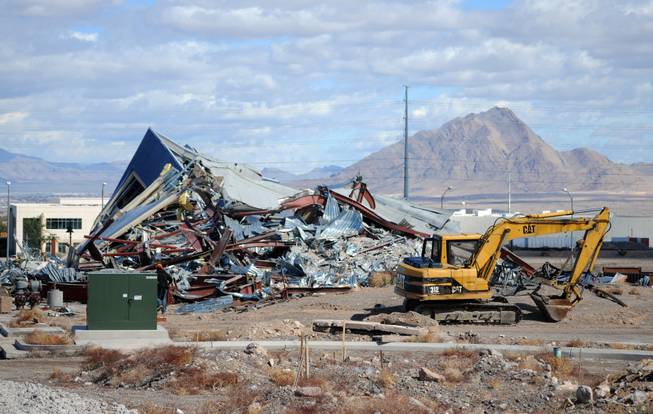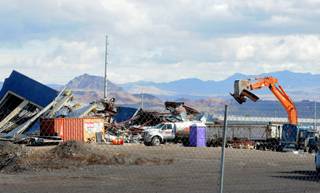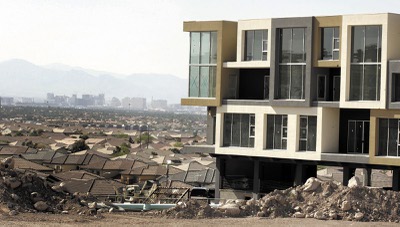
A Henderson demolition crew demolishes a building on the failed $200-million Stephanie Village project, located on the corner of Stephanie Street and Wigwam Parkway.
Thursday, March 24, 2011 | 2:01 a.m.
Sun archives
- Recession could be opportunity to reshape, improve communities (1-2-2011)
- We’re stuck, so will we bond? (12-25-2010)
- Housing market continues slide in Las Vegas (12-21-2010)
- Boom-bust era leaves architectural scars across valley (12-19-2010)
- Foreclosed homes a bane to neighbors in Las Vegas Valley communities (12-10-2010)
- Las Vegas population in decline; will it reverse? (11-13-2010)
- All signs point to continuing Las Vegas exodus (9-2-2010)
- Lessons Las Vegas can learn from the Rust Belt (10-11-2009)
- The potential for prosperity in Las Vegas (9-9-2009)
- Experts: Despite downturn, Las Vegas has hope (9-8-2009)
- An early chapter in Vegas architecture (3-26-2009)
- How we’ll live post-sprawl (3-2-2009)
- In varied Vegas, two buildings spark architectural debate (5-25-2008)
WinCo Foods location
When it was built in 2008, the gleaming, two-story office building in Henderson was the first milestone for an ambitious $200 million condominium project known enticingly as 17th and Vine. The mixed-use project was designed when the economic stars seemed aligned and developers couldn’t miss.
They never thought the economy would crash, and crash so hard so quickly.
That building, meant to be the clubhouse for the 22.5-acre property at 64 N. Stephanie St., was never occupied. And last week, it was demolished, left in a pile of steel, glass and concrete — and with it, the vestiges of a bold promise once made and broken.
“Clearly, if we had a crystal ball, most people in town wouldn’t have built what we did,” said Dan Shaw, an original developer of the project. “Now, we need to find new uses for existing and vacant projects that will be beneficial for everyone.”
As urban developers and planners debate what to do with the partially built remnants of Las Vegas’ gilded age, examples of grandiose, boom-era plans scrapped for more humble, recession-era projects will become more common, they said. And sometimes, perfectly good buildings might be demolished to pave the way.
In the case of 17th and Vine, later renamed Stephanie Village under different management, the new property owner is WinCo Foods, an Idaho grocery chain making its first foray into Southern Nevada.
“Las Vegas is a market we’ve had an interest in for a couple of years,” WinCo spokesman Michael Read said. “We think our business model of an employee-owned, discount grocery will do well in this environment.”
WinCo plans to build a 95,000-square-foot store on 17.5 acres. It’s a smaller, more modest plan than 17th and Vine’s 10-building, 466-condo project proposed in 2005.
“In the height of the economy, these projects made sense, but once (the economy) deteriorated, they don’t make sense,” said Shaw, a former Henderson planning commissioner who is on the Clark County Planning Commission. “We’re now seeing a remake of a number of projects that are better suited for the financial times.”
Henderson Planning Manager Michael Tassi said he is beginning to see a few large mixed-use commercial projects, stalled in the recession but slowly moving forward with modified plans. Green Valley Crossing at Green Valley Parkway and Horizon Ridge was proposed as a mixed-use commercial development, but the developers are looking at a residential use, Tassi said.
At Seven Hills Drive and St. Rose Parkway, La Piazza commercial center was proposed as a mixed-use commercial development. In late January, Henderson approved zone changes to allow a portion of the 11 acres to develop as a commercial-only, medical and office complex.
“We’re still developing, which is positive for us,” Tassi said. “We try to be flexible and work with developers to do what’s best for Henderson and our residents.”
Still, countless stalled projects dot the Las Vegas Valley — many of them indefinitely — like scars left on the desert’s dusty face. Just down the street from the proposed WinCo store is Park Heights, a high-rise condominium project that never got off the ground. Architects and planners say some of the boom-era projects may face demolition for smaller developments.
“It’s tragic they have to do that,” Henderson-based RAFI architect Robert Fielden said. “There are 1,000 other buildings around the valley that probably will have to do this as well.”
What planners and architects hope to see in the post-recession development phase is a focus on residents and creating a sense of neighborhood.
“All of those projects were envisioned beyond the means of the developer or even the needs of this community,” Fielden said. “Las Vegas has been good about getting property taxes up, but has done a lousy job at creating community.”
He points to the stalled, $160 million Vantage Lofts at Paseo Verde Parkway and Gibson Road as an example of a partially built development that sits at odds with its environment.
“It’s a very urban structure built in a suburban context,” Fielden said, mentioning the single-family houses surrounding it. “Its presence and scale is far more grand than its surrounding setting. It’s like a giant stork dropped it down there.”
The emphasis for developers is smaller, sustainable and walkable communities that work with the surrounding neighborhood and build a sense of community, he said.
Yet large, mixed-use commercial developments may still play a role to that end, said Windom Kimsey of the Tate Snyder Kimsey architecture firm.
“It reduces the amount of drive time,” the Henderson-based architect said. “It’s still a good model and it’s successful in other cities such as Phoenix and L.A., where there were no existing urban neighborhoods.”
For Kimsey, seeing the “labor and energy” that went into creating boom-era projects now wasted “bothered” him.
“People can be creative in the ways we can reuse mixed-used developments,” he said, counting artist lofts and classrooms as some alternative uses for a site like Vantage Lofts. “We shouldn’t be building things to be torn down.”
In Henderson, city planners approved a development code last year to better execute its master plan, adopted in 2006 during the height of the economic boom. The code, which is being reviewed, allows developers more leeway to change projects.
“It’s flexible, so developers have more options,” Tassi said. But, “our goals in the master plan remain the same: We want a vibrant community that’s strong and diverse.”
Shaw also emphasized flexibility.
“We’re making a real effort to create more sustainable and walkable neighborhoods with more trails, better access to public transportation and more parks,” Shaw said. “I think that’s the lesson that has been learned.”



Join the Discussion:
Check this out for a full explanation of our conversion to the LiveFyre commenting system and instructions on how to sign up for an account.
Full comments policy